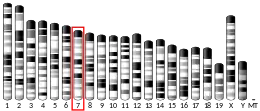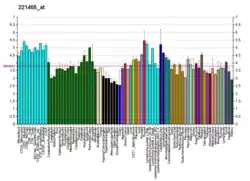OR6A2
Olfactory receptor 6A2 is a protein that in humans is encoded by the OR6A2 gene.[5]
| OR6A2 | |||||||||||||||||||||||||
|---|---|---|---|---|---|---|---|---|---|---|---|---|---|---|---|---|---|---|---|---|---|---|---|---|---|
| Identifiers | |||||||||||||||||||||||||
| Aliases | OR6A2, I7, OR11-55, OR6A1, OR6A2P, olfactory receptor family 6 subfamily A member 2 | ||||||||||||||||||||||||
| External IDs | OMIM: 608495 MGI: 97432 HomoloGene: 2743 GeneCards: OR6A2 | ||||||||||||||||||||||||
| |||||||||||||||||||||||||
| |||||||||||||||||||||||||
| |||||||||||||||||||||||||
| |||||||||||||||||||||||||
| Orthologs | |||||||||||||||||||||||||
| Species | Human | Mouse | |||||||||||||||||||||||
| Entrez | |||||||||||||||||||||||||
| Ensembl | |||||||||||||||||||||||||
| UniProt |
| ||||||||||||||||||||||||
| RefSeq (mRNA) | |||||||||||||||||||||||||
| RefSeq (protein) |
| ||||||||||||||||||||||||
| Location (UCSC) | Chr 11: 6.79 – 6.8 Mb | Chr 7: 106.59 – 106.61 Mb | |||||||||||||||||||||||
| PubMed search | [3] | [4] | |||||||||||||||||||||||
| Wikidata | |||||||||||||||||||||||||
| |||||||||||||||||||||||||
Function
Olfactory receptors interact with odorant molecules in the nose, to initiate a neuronal response that triggers the perception of a smell. The olfactory receptor proteins are members of a large family of G-protein-coupled receptors (GPCR) arising from single coding-exon genes. Olfactory receptors share a 7-transmembrane domain structure with many neurotransmitters and hormone receptors and are responsible for the recognition and G protein-mediated transduction of odorant signals. The olfactory receptor gene family is the largest in the genome. The nomenclature assigned to the olfactory receptor genes and proteins for this organism is independent of other organisms.[5]
Clinical significance
Variation in the OR6A2 gene has been identified as a likely cause of why some people enjoy the smell and taste of coriander (also known as cilantro)[6] while others have exactly the opposite reaction to the point of repulsion. Depending on ancestry, somewhere between 3% and 21% of the population associate it with unpleasant taste, including a combination of soap and vomit, or say that it is similar to the foul smelling odor emitted by stinkbugs. This is due to the presence of aldehyde chemicals, which are present in soap, various detergents, coriander, several species of stinkbugs and cinnamon.[7]
See also
References
- GRCh38: Ensembl release 89: ENSG00000184933 - Ensembl, May 2017
- GRCm38: Ensembl release 89: ENSMUSG00000070417 - Ensembl, May 2017
- "Human PubMed Reference:". National Center for Biotechnology Information, U.S. National Library of Medicine.
- "Mouse PubMed Reference:". National Center for Biotechnology Information, U.S. National Library of Medicine.
- "Entrez Gene: OR6A2 olfactory receptor, family 6, subfamily A, member 2".
- Eriksson N; Wu S; Chuong BD; et al. (29 November 2012). "A genetic variant near olfactory receptor genes influences cilantro preference". Flavour. 1. arXiv:1209.2096. doi:10.1186/2044-7248-1-22. S2CID 199627.
- Callaway E (September 2012). "Soapy taste of coriander linked to genetic variants". Nature. doi:10.1038/nature.2012.11398. S2CID 87980895.
Further reading
- Buettner JA, Glusman G, Ben-Arie N, et al. (1998). "Organization and evolution of olfactory receptor genes on human chromosome 11". Genomics. 53 (1): 56–68. doi:10.1006/geno.1998.5422. PMID 9787077.
- Lane RP, Cutforth T, Young J, et al. (2001). "Genomic analysis of orthologous mouse and human olfactory receptor loci". Proc. Natl. Acad. Sci. U.S.A. 98 (13): 7390–5. Bibcode:2001PNAS...98.7390L. doi:10.1073/pnas.131215398. PMC 34679. PMID 11416212.
- Strausberg RL, Feingold EA, Grouse LH, et al. (2003). "Generation and initial analysis of more than 15,000 full-length human and mouse cDNA sequences". Proc. Natl. Acad. Sci. U.S.A. 99 (26): 16899–903. doi:10.1073/pnas.242603899. PMC 139241. PMID 12477932.
- Malnic B, Godfrey PA, Buck LB (2004). "The human olfactory receptor gene family". Proc. Natl. Acad. Sci. U.S.A. 101 (8): 2584–9. Bibcode:2004PNAS..101.2584M. doi:10.1073/pnas.0307882100. PMC 356993. PMID 14983052.
- Gerhard DS, Wagner L, Feingold EA, et al. (2004). "The Status, Quality, and Expansion of the NIH Full-Length cDNA Project: The Mammalian Gene Collection (MGC)". Genome Res. 14 (10B): 2121–7. doi:10.1101/gr.2596504. PMC 528928. PMID 15489334.
External links
- OR6A2+protein,+human at the US National Library of Medicine Medical Subject Headings (MeSH)
This article incorporates text from the United States National Library of Medicine, which is in the public domain.




